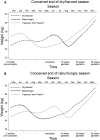Preconceptional and gestational weight trajectories and risk of delivering a small-for-gestational-age baby in rural Gambia
- PMID: 28490512
- PMCID: PMC5445671
- DOI: 10.3945/ajcn.116.144196
Preconceptional and gestational weight trajectories and risk of delivering a small-for-gestational-age baby in rural Gambia
Abstract
Background: Maternal nutritional status is a key determinant of small for gestational age (SGA), but some knowledge gaps remain, particularly regarding the role of the energy balance entering pregnancy.Objective: We investigated how preconceptional and gestational weight trajectories (summarized by individual-level traits) are associated with SGA risk in rural Gambia.Design: The sample comprised 670 women in a trial with serial weight data (7310 observations) that were available before and during pregnancy. Individual trajectories from 6 mo before conception to 30 wk of gestation were produced with the use of multilevel modeling. Summary traits were expressed as weight z scores [weight z score at 3 mo preconception (zwt-3 mo), weight z score at conception, weight z score at 3 mo postconception, weight z score at 7 mo postconception (zwt+7 mo), and conditional measures that represented the change from the preceding time] and were related to SGA risk with the use of Poisson regression with confounder adjustment; linear splines were used to account for nonlinearity.Results: Maternal weight at each time point had a consistent nonlinear relation with SGA risk. For example, the zwt-3 mo estimate was stronger in women with values ≤0.5 (RR: 0.736; 95% CI: 0.594, 0.910) than in women with values >0.5 (RR: 0.920; 95% CI: 0.682, 1.241). The former group had the highest observed SGA prevalence. Focusing on weight change, only conditional zwt+7 mo was associated with SGA and only in women with values >-0.5 (RR: 0.579; 95% CI: 0.463, 0.724).Conclusions: Protection against delivering an SGA neonate offered by greater preconceptional or gestational weight may be most pronounced in more undernourished and vulnerable women. Independent of this possibility, greater second- and third-trimester weight gain beyond a threshold may be protective. This trial was registered at http://www.isrctn.com/ as ISRCTN49285450.
Keywords: age-related trajectories; gestational weight gain; maternal nutrition; prepregnancy weight; small for gestational age.
Figures


Similar articles
-
Maternal plasma lipid levels across pregnancy and the risks of small-for-gestational age and low birth weight: a cohort study from rural Gambia.BMC Pregnancy Childbirth. 2020 Mar 12;20(1):153. doi: 10.1186/s12884-020-2834-1. BMC Pregnancy Childbirth. 2020. PMID: 32164563 Free PMC article. Clinical Trial.
-
The relative influence of maternal nutritional status before and during pregnancy on birth outcomes in Vietnam.Eur J Obstet Gynecol Reprod Biol. 2015 Nov;194:223-7. doi: 10.1016/j.ejogrb.2015.09.018. Epub 2015 Sep 28. Eur J Obstet Gynecol Reprod Biol. 2015. PMID: 26454228 Clinical Trial.
-
Competing-risks model for prediction of small-for-gestational-age neonate from maternal characteristics and medical history.Ultrasound Obstet Gynecol. 2020 Aug;56(2):196-205. doi: 10.1002/uog.22129. Epub 2020 Jul 10. Ultrasound Obstet Gynecol. 2020. PMID: 32573831
-
Nutritional aspects of preconceptional period as related to pregnancy and early infancy.Prog Food Nutr Sci. 1986;10(1-2):205-36. Prog Food Nutr Sci. 1986. PMID: 3538186 Review.
-
Early-Life Nutritional Programming of Health and Disease in The Gambia.Ann Nutr Metab. 2017;70(3):179-183. doi: 10.1159/000456555. Epub 2017 Mar 17. Ann Nutr Metab. 2017. PMID: 28301842 Review.
Cited by
-
Suboptimal gestational weight gain and neonatal outcomes in low and middle income countries: individual participant data meta-analysis.BMJ. 2023 Sep 21;382:e072249. doi: 10.1136/bmj-2022-072249. BMJ. 2023. PMID: 37734757 Free PMC article.
-
Maternal plasma lipid levels across pregnancy and the risks of small-for-gestational age and low birth weight: a cohort study from rural Gambia.BMC Pregnancy Childbirth. 2020 Mar 12;20(1):153. doi: 10.1186/s12884-020-2834-1. BMC Pregnancy Childbirth. 2020. PMID: 32164563 Free PMC article. Clinical Trial.
-
Associations between growth from birth to 18 years, intelligence, and schooling in a Brazilian cohort.Am J Clin Nutr. 2020 Jul 1;112(1):187-194. doi: 10.1093/ajcn/nqaa047. Am J Clin Nutr. 2020. PMID: 32239193 Free PMC article.
-
Gestational weight gain during the second and third trimesters and adverse pregnancy outcomes, results from a prospective pregnancy cohort in urban Tanzania.Reprod Health. 2022 Jun 16;19(1):140. doi: 10.1186/s12978-022-01441-7. Reprod Health. 2022. PMID: 35710384 Free PMC article. Clinical Trial.
-
Nutritional and Hematological Status of Sudanese Women of Childbearing Age with Steady-state Sickle Cell Anemia.Oman Med J. 2021 May 31;36(3):e270. doi: 10.5001/omj.2021.81. eCollection 2021 May. Oman Med J. 2021. PMID: 34164159 Free PMC article.
References
-
- Lee AC, Katz J, Blencowe H, Cousens S, Kozuki N, Vogel JP, Adair L, Baqui AH, Bhutta ZA, Caulfield LE, et al. . National and regional estimates of term and preterm babies born small for gestational age in 138 low-income and middle-income countries in 2010. Lancet Glob Health 2013;1:e26–36. - PMC - PubMed
-
- Jaquet D, Deghmoun S, Chevenne D, Collin D, Czernichow P, Levy-Marchal C. Dynamic change in adiposity from fetal to postnatal life is involved in the metabolic syndrome associated with reduced fetal growth. Diabetologia 2005;48:849–55. - PubMed
-
- Jaquet D, Gaboriau A, Czernichow P, Levy-Marchal C. Insulin resistance early in adulthood in subjects born with intrauterine growth retardation. J Clin Endocrinol Metab 2000;85:1401–6. - PubMed
Publication types
MeSH terms
Grants and funding
LinkOut - more resources
Full Text Sources
Other Literature Sources
Medical

